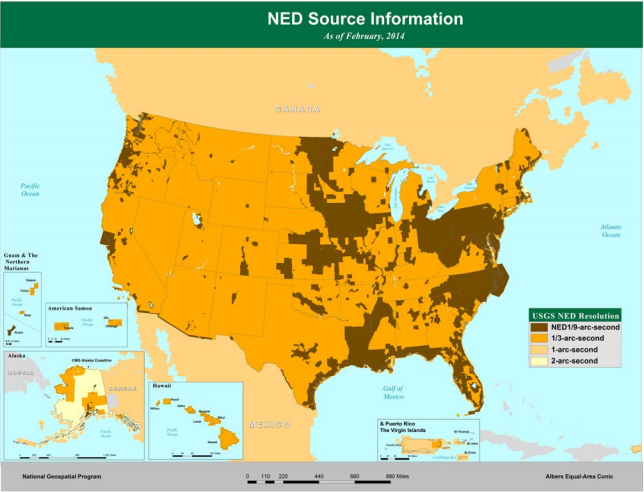Difference between revisions of "National Elevation Dataset"
m |
m (→Introduction) |
||
| Line 4: | Line 4: | ||
The NED is generated at various horizontal resolutions to serve the needs of local, regional and nationwide applications. These various resolutions, referred to as NED layers, are stored and distributed in geographic coordinates at 1/9, 1/3, 1, and 2 seconds of arc. Each of these layers is derived from the highest quality DEMs available in the NED source database for any geographic location within the conterminous United States, Alaska, Hawaii, Puerto Rico, U.S. territorial islands, Mexico and Canada. The extent of geographic coverage varies by layer. | The NED is generated at various horizontal resolutions to serve the needs of local, regional and nationwide applications. These various resolutions, referred to as NED layers, are stored and distributed in geographic coordinates at 1/9, 1/3, 1, and 2 seconds of arc. Each of these layers is derived from the highest quality DEMs available in the NED source database for any geographic location within the conterminous United States, Alaska, Hawaii, Puerto Rico, U.S. territorial islands, Mexico and Canada. The extent of geographic coverage varies by layer. | ||
| + | |||
| + | === Dataset Overview === | ||
| + | * '''Spatial Coverage:''' United States | ||
| + | * '''Resolution:''' 1/9 arc-seconds () and 1/3 arc-seconds | ||
| + | * '''Data-type:''' [[:Category%3ADigital_Elevation_Models#What_type_of_elevation_model.3F_DEM.2C_DSM_and_DTM.3F|Digital Terrain Models (DTM) and Digital Surface Models (DSM)]] | ||
| + | * '''Coordinate system:''' Austrian Lambert (EPSG 31287) in original data | ||
| + | * '''Version:''' Data downloaded in 2013. | ||
| + | * '''Vertical Accuracy:''' 0.05m (for original 0.4m grided data) | ||
== Availability from within WindPRO == | == Availability from within WindPRO == | ||
Revision as of 09:57, 24 June 2020
Introduction
The National Elevation Dataset (NED) is the primary elevation data product of the USGS and serves as the elevation layer of The National Map. The NED provides basic elevation information for earth science studies and mapping applications in the United States. Scientists and resource managers use the NED data for global change research, hydrologic modeling, resource monitoring, mapping, visualization, and many other applications. The NED is updated continually to integrate newly available, improved elevation source data. All NED data are public domain.
The NED is generated at various horizontal resolutions to serve the needs of local, regional and nationwide applications. These various resolutions, referred to as NED layers, are stored and distributed in geographic coordinates at 1/9, 1/3, 1, and 2 seconds of arc. Each of these layers is derived from the highest quality DEMs available in the NED source database for any geographic location within the conterminous United States, Alaska, Hawaii, Puerto Rico, U.S. territorial islands, Mexico and Canada. The extent of geographic coverage varies by layer.
Dataset Overview
- Spatial Coverage: United States
- Resolution: 1/9 arc-seconds () and 1/3 arc-seconds
- Data-type: Digital Terrain Models (DTM) and Digital Surface Models (DSM)
- Coordinate system: Austrian Lambert (EPSG 31287) in original data
- Version: Data downloaded in 2013.
- Vertical Accuracy: 0.05m (for original 0.4m grided data)
Availability from within WindPRO
The data are available directly from within WindPRO in 1/3 and 1 seconds of arc. The data can be accessed from the online-services in the following objects:
- Line Object (with purpose to height contour lines)
- Elevation Grid Object
In addition to loading the data directly from the EMD online services, WindPRO also supports importing the original *.hgt files that can also be downloaded from other internet sources.
Data Type
The NED data are delivered as gridded data with a spatial resolution of the dataset corresponding to 1 or 1/3 arc seconds, i.e. approximately 30 or 10 m distance between grid points. As a part of the processing of the NED data from our EMD server, the user has an option of choosing whether the data downloaded should be received as either raw gridded data or converted to height contour lines. In order to use the data for energy yield calculations, the data must be converted to contours.
Coverage
A view of the data coverage is shown in the figure below.
External Links
- More information on NED is available at http://ned.usgs.gov
Acknowledgement
USGS (U.S. Geological Survey) are thanked for making this great digital elevation dataset available in the public domain and thus for aiding the development of renewable energy.
